Phra Chulachomklao Fort
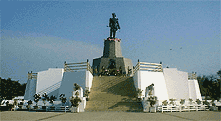
Phra Chulachomklao Fort is an important historical fort that is worth visiting because it represents a sagacious perception of King Rama V.
He prepared and constructed this fort as a stronghold against forces especially European nations who were hunger for colonies. This fort was once used to fight against French warships
Phra Chulachomklao fort is situated at the estuary of Chao Pra Ya river, locality of Laem Fha Pa, Samut Chedi district, Samut Prakarn province where is not far from Bangkok. Travelling on Thonburi side uses Suksawat road (National road number 303). Phra Chulachomklao fort is about seven kilometres from Samut Chedi junction. The fort is open for public with free entry. You only need to make your request to the naval guards at the entrance, exchange your ID a for visitor card then you can drive through to visit the fort. Optional transportation is public bus no. 20, which will stop right at the fort.
The history of Phra chulachomklao fort.
King Rama V (King Chulachomklao) ascended the throne and, then, he was concerned that the existing forts were too old and incapable to protect the kingdom. At the mean time, European nations were trying to colonize countries in East Asia. Neighbouring countries of Thailand; Viet Nam, Cambodia, Laos, Burma, Singapore, Malaysia; were all colonized. So there was a tendency that they also intended to occupy Thailand. When seemly bad situation occurred, King Rama V had a royal comand to urgently build a new fort at the estuary of Chao Pra Ya river. The construction commenced in 1884 and completed in 1893. The fort was then named 'Phra Chulachomklao fort' as he wished to give two royal names for the fort. The paragraph below is an abstract from the King's written letter to his ministers.
'It has been an ambition over the past nine years and one month that I wish to name the newly built fort; Chulalonkorn or Chulachomklao; as any other forts that have been named after their Kings, for example, Fort Williams in Calcutta. And since this construction has been under royal financial support, it is meant to have such names. If you all agree with this intention, may you please select one of the two aforementioned names for the fort and bring the fort a cheerfulness and future extensive reputation.'
The ministers agreed to choose 'Chulachomklao' to be a name for the new fort. The king Rama V came to officially open the fort on April 10th, 1893 (Bangkok year 112) and he tested the gun firing himself.
When we arrived Phra Chulachomklao fort, the first important thing that attracts us is the royal Monument of King Rama V. This monument is majestically standing in front of the fort and it is the centre of this area that is surrounded by various types of trees. The monument was built in 1993. It has total height of 17.50 metres. The King's image is 4.2 m tall, 2.5 times the king's actual size, majestically dressed in the naval supreme commander uniform. On October 23rd every year, there is a ceremony, which Royal Thai Navy lay wreath for the memorial of the great king.
At the back of the monument, there is a Phra Chulachomklao exhibition room. At the fort entrance, there is a stone inscription, considered as a symbol of this place, which says;
'In April 1893 (Bangkok year 112), King Rama V was here to observe the construction of the fort at Laem fah Pa locality. He saw a lot of works had to be completed in order to make this fort capable to protect the capital. He, therefore, provided his royal financial support to urgently carry out all remained works. This completed fort was then name after the king, Chulachomklao Fort', in Bangkok year 112'.
The fort's interior was designed as a western style that was then popular and most updated. The corridor is small and narrow. The ceiling is 2 m high and in tortoise shape i.e. curvy down to both sides. There are numbers of small rooms for storing ammunition and war equipment. But, at present, there are left unattended to be dark, stuffy, humid and scary to get in. There are small vent holes on the wall. Important event in the past is that the fort was flooded. Water level was about 30-40 cm. This is noticeable since there is a distinct colour on the wall that evidentially represents the level of water during the flood.

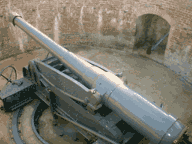
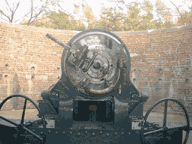
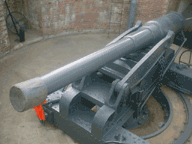
Along the length of Chulachomklao fort, there are 7 holes for cannon positioning. These cannon are called Puen Sua Morb (crouching tiger cannon). Interesting characteristics are as below.
Characteristics of Peun Sua Morb
-
152/32 mm cannon, made by Sir W G Armstrong Company
-
(SIR W.G. ARMSTRONG) United Kingdom
-
King Rama V gave his royal permission to construct Phra Chulachomklao fort in 1893, financially supported by his personal financial aid, which also acquire cannons.
-
A cannon weighs 5 tons
-
Ammunition socket is 200 mm wide
-
The barrel length is 32 times its calibre (4.864 m)
-
Total length of cannon is 5.20 m.
-
Barrel's 28 doubled, to the right, helical grooves
-
Shooting range is 8,046 metres End-loaded type cannon. A shell, 3 parts separated, consisted of bullet head, gun powder and ammunition powder
-
10 men per 1 cannon point (7 men for operating cannon, 3 men for loading shell)
-
Highest lifted angle is 15 degrees, lowest angle is -3 degrees
-
Cannon was lifted when firing, lowered down when firing completed
Both left and right side of the cannon are, which are higher than the cannon hole, are enemy observation area. There is a small staircase for climbing up there. The area is circular with metal roof. All 7 cannons can be seen from here, so is Wat Asokaram
When we nearly finish exploring Phra Chulachomklao fort, we were coming outside. There are many big rooms along the aisle. After several close observations, we learnt that there are rooms for storing fresh water. Since this area is close to the sea where fresh water is rare, so it is essential to build these rooms with big tanks for fresh water.
Interesting historical event was that after the Phra Chulachomklao fort had been officially open for only two months, the Bangkok year 112 event occurred.This memorable event took place on July 13rd, 1893. French warships intruded Thai sovereignty. Thai forces made warning shooting and intercepted those warships. They manage to strand the French navigating ship, Ge' Be' Se'e, at Lumpurai peninsula. But the ship In Cont Stane (or Comette) managed to break through the defense line and casting their anchors in front of the French embassy. This situation lead to the Bangkok Year 112 event.
Visiting Phra Chulachomklao, despite of tiring tours inside the fort and rather hot weather, when you are touched by cool breezes while resting in shades of big trees in this area it makes you feel fresh and you soon regain your strength. So, you can carry on visiting HMS Mae Klong.
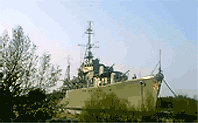
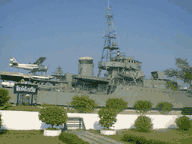
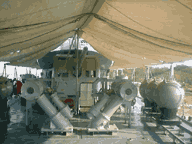
HMS Mae Klongwas commissioned in 1937. She had been deployed in several important missions such as a royal ship for King Rama VIII and King Rama IX, taking part of operations in East Asian war and, also, a ship for training naval cadets and navy technical students, so she is considered to be a master of naval men. She was built in Japan with 1400 tons of displacement tonnage, 173 commissioned men, two steam turbine engines which can produce 2500 horse power, twin propellers, maximum speed 17 knots (sea mile/hr), economy speed 8-10 knots, operation range 16,000 miles, ship weapons are;
1. Four 120 cannons
2. Twin 20 mm medium gun
3. Two twin 45 mm torpedo launchers
4. Two Paravanes (mine sweepers)
5. Two depth charge launchers
6. Two mine releaser rails
7. A sea plane
She was decommissioned in 1994, after 59 years in operation, which is the longest time in the Navy record. The surrounding area is a park.
The Navy has built a Thai warship museum for the honour of the king Bhumibol in the occasion of his Golden Jubilee (50 years in his thrones). The HMS Mae Klong is made, for conservation, an outdoor warship museum at Phra Chulachomklao fort for the benefits in history and military development study. This museum also complies with the king's consideration to conserve important ex-commissioned warships.
Visiting Phra Chulachomklao fort and HMS Mae klong is worthwhile. We gained both knowledge and entertainment. Before our departure, it is recommended to visit and pay respect to King Narayana shrine. This shrine is in front of the King Chulachomklao monument. You can both pay respect and try your luck on 'Sium See'(Chinese style fortune-telling sticks).
Take your own spare time to visit Phra Chulachomklao museum. You will be fascinated by unforgettable knowledge and enterainment.
Translator : Aketawan Manowongsa
12 July 2000
Read more articles in ![]() Tourism and leisure
Tourism and leisure
Wat Arunrachawararam(Temple of
Dawn) |
Phra Chulachomklao Fort |
Wat Pra Chetupon, University for
people |
Wat Prasi Ratana Sasdaram (The
temple of the Emerald Buddha) |
Wat Bowornstan Suthawas (The temple inside the Palace, Ratanakosin period) |
Khao Yee San Village |
The Suan Pakkad Palace Museum |
Ban Krua Community |
The Princess Mother (HRH Somdet Phra Srinagarindra Boromrajajonnani) Commemorative Park |
The Thai Labour Museum |
![]() Home
Home